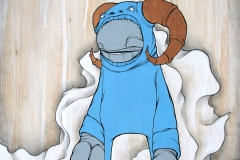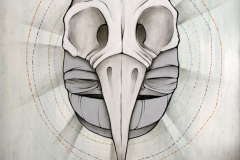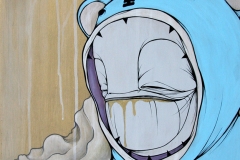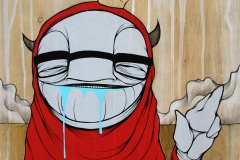An Interview with Dylan Bradway
 by Kathleen Shannon
by Kathleen Shannon
June 1, 2011
Dylan Bradway and his wife Amanda are impossibly cool. Let me paint a picture for you: They own a contemporary urban art gallery, DNA Galleries, in an up-and-coming but still-shady-enough-for-good-street-cred area of Oklahoma City. They were living in the back of the gallery until they recently decided to purchase a completely gutted 1920s home to remodel by themselves. They’re young artists with big style and big dreams—not just for themselves but for their community.
I first met Dylan Bradway when we were both asked to speak to a class at the University of Central Oklahoma about being creative entrepreneurs. It was 10 a.m. on a Saturday morning—I went first, walking a classroom full of seemingly uninterested students through the story of how I became a freelance designer. I cracked jokes, and upon my delivery I swear I could hear the cliché crickets chirping. Then it was Dylan’s turn. He showed the same unresponsive room full of students his work as he rubbed the sleepy out of his eyes. But I was captivated. While the students didn’t have very many questions for him, I had dozens.
The Fiddleback: Tell me a little bit about DNA Galleries. What’s it like owning a contemporary urban art gallery in Oklahoma?
Dylan Bradway: DNA Galleries officially started around October 2008, meaning that’s when we got set up as a business. We’re an urban contemporary gallery and retail space and we try to keep it as local as possible meaning around 70-75 percent. My wife Amanda really runs the joint for the most part, but I help her with art and product design and choices as well as curating and hanging the art shows.
It’s a great feeling to have a unique gallery in our growing little city. We get to support talented artists that range from the established to first timers. Oklahoma is such a wonderful place to do this kind of thing because there are so many talented people looking for a place to display their craft. But don’t get me wrong—it isn’t the easiest thing in the world. Selling art in general is a difficult task because many people do not appreciate the value of art. This can be even more difficult when you have prices and styles that have such a broad spectrum.
The Fiddleback: I think there is lots of inspiration to be found here in Oklahoma City, but are there any cities or places that inspire you and your art?
DB: I feel very much the same about Oklahoma City—this little gem is full of inspiration. I try to find inspiration everywhere I go so that my ideas can stay fresh and hopefully evolve organically with my experience. When it comes to other cities and places, I have always loved Portland, Ore. and the surrounding area—Northern California, Vancouver, Washington—as well as any other place that is surrounded by a beautiful and lush landscape. Recently I’ve become more and more interested in large cities because of their urban density and diversity. I think this was sparked by a trip I took to Hannover Germany for a solo show I had there in 2009. Everything was so fresh and new to me that with every turn I couldn’t help but be inspired.
The Fiddleback: You own DNA Galleries with your wife, Amanda, who is also an amazing artist. Do you two ever collaborate on projects or give each other feedback on works in progress? What’s that like?
DB: We collaborate constantly and it is such a great way to build on new ideas. We are actually planning a big installation piece that is filled with collaborative pieces, but I won’t spoil it with too many details. In the past we have also collaborated with each other and/or multiple other artists on large live murals and commission pieces. There is a different kind of energy when you work with others, it seems to make the creativity fluid, and you start to build off of all the ideas and create something new.
The Fiddleback: When I look at the characters in your work I feel a sweet sadness for them. They’re creepy yet fragile – they seem like they have lots of stories to tell. Do you write stories for the characters in your paintings? What’s your process for giving your work so much personality?
DB: I don’t currently write full stories, but there is a string of thoughts that build the personality of the characters. My mind is constantly processing little bits of my current environment and the inspirations from my past. Then once I’m in the zone working on a piece everything kind of blends together, and I pull ideas from the mix to help define them.
The Fiddleback: I love how the lines in your paintings translate over to your graphic design work. Can you tell me a little bit about how your paintings and design work influence each other?
DB: Since becoming a designer my appreciation for typography has grown, and I have been pulling that into my artwork. Overall I think the relationship stems from my love of detail as well as clean lines and color, which seem to cross over between the two creative areas.
The Fiddleback: What are you listening to these days?
DB: This is a fun question. I am a huge hip-hop fan but I like all kinds of music so here is my list in no order: Kid Cudi, The Hood Internet, King Fantastic, Diplo (especially the Free Gucci mixtape), Wiz Khalifa, Grizzly Bear, Broken Social Scene, Vampire Weekend, Prefuse 73, Animal Collective and I can’t wait for the new Beastie Boys Hot Sauce Committee Pt. 2 to drop.
The Fiddleback: Having a day job, owning a gallery, remodeling an old home and being an artist seems like a lot of work. How do you manage your time? How do you deal with creative blocks or burnout?
DB: Currently I’m trying to minimize the amount of focus areas in my life so I can relax a little. I’ll admit my time management skills aren’t the best. Basically what I do is divide my time up into what I can get done that day or week and keep a good eye on deadlines. I will say I still pull some late nights, and if there is downtime anywhere, even at my day job, I will do small stuff like sketch ideas or promote an event at the gallery.
Burnout is an ever-looming monster, and something I try to keep at bay if possible. I realized that time management and personal goals can help with burnout. I mean, pick the things you want to do and do them well, and if you don’t think a project is a good fit then “no” is a fine answer. When it comes to creative blocks, I either move on to something else and come back to the project that is giving me trouble, or I go hunting for inspiration to free up my thoughts.
The Fiddleback: What’s next? Are there any projects on the horizon that you’re really excited about?
DB: I do have a show at 1614 in the Plaza District this September, which will be all new work. But the biggie is the collaborative installation that my wife Amanda and I are planning for the next Momentum in Oklahoma City scheduled for March 2012. It aims to be a somewhat interactive environment filled/covered with collaborative pieces of all sizes for the viewers to experience and purchase individually. This is a huge project that we have to start now for next year, so it will probably be taking up a lot of time and energy.
——–
Dylan Bradway



